:dropcap_open:D:dropcap_close:r. Tim Maggs is the current Director of Sports Biomechanics at Christian Brothers Academy in Albany, New York. He will provide his Structural Management® Program to their highly successful athletic department. This is the first time a chiropractor has had such an influential role in Christian Brothers Academy middle or high school athletic department. Dr. Maggs is in his 35th year of practice and has always had a sports-based practice. He is a graduate of National College of Chiropractic and completed his undergraduate work at the State University of New York. In an interview with The American Chiropractor, Dr. Maggs explains what drives him in providing this type of care, as well as explaining what the Structurtal Management® Program involves.
 TAC: Dr. Maggs, let’s start with a little about your background.
TAC: Dr. Maggs, let’s start with a little about your background.TM: My practice is filled with health-oriented, active people. We don’t get the acute, antalgic patient coming in. We’ve really done a great job of making our care part of people’s lifestyles. So, once they begin care with us, our goal is for them to go through enough care to “fix” their problems, then have them stay on at some frequency in an effort to “manage” their musculoskeletal systems throughout their lives.
TAC: When did you get interested in working with high school athletes?
TM: In 1979, immediately after graduating, I began working with the football team in my town. Twice a week I would go to their practices, and didn’t really know what to do with them, so I adjusted those athletes who would let me. I didn’t get paid, and I didn’t do too much of an exam on them. I don’t think I even got parental approval back then. But my goal was to work with athletes, and that’s what I did. Until the school doc got wind of what I was doing and asked the athletic director to ban me from the campus, which he did. So I’ve spent the last 34 years figuring out how to get back to working with high school athletes, but this time, through the front door. Eight years ago, we started our Concerned Parents of Young Athletes™ Program, a program designed strictly to raise the awareness of sports biomechanics in the middle and high school age group. My Structural Management® Program is a comprehensive biomechanical program we use on all of these athletes.
TAC: Why is it difficult to have access to high school athletes?
TM: There is an epidemic failure in the field of sports medicine to understand how to truly take care of athletes. The law of minimalism defines the care that high school athletes receive, and the medical model guides the practitioner. School districts defend this weak, reactive approach. The approach that I’m incorporating at CBA, and one that every school in the country needs, is a proactive, biomechanical model that looks at all athletes before injuries occur. It’s difficult to get access to high schools because the politics of health care, the egos of local orthopods who are in charge, and the ignorance of athletic directors and coaches keeps the system in the dark ages.
TAC: What are some of the negative experiences you had prior to finally getting this appointment?
TM: I’ve met with more athletic directors than I can count, boards of directors of school systems, even superintendents of school districts. I’ve met with coaches, parents, and athletes. The biggest disappointment is always that they don’t have my vision. It’s like 50 years ago, hoping someone would see every person having a phone/camera/computer/GPS/phone book/etc. in their pockets. No one could ever imagine what that would look like. So the amount of time and energy that I’ve exerted in this journey was absolutely necessary for me to get where I’m finally at today.
TAC: What does the title Director of Sports Biomechanics entail?
TM: This was a department the school and I had to create. No other school in the country, that I’m aware of, has a department for biomechanics. Many schools feel progressive if they have a bigger strength department. But, that in no way even comes close to what we’re offering at CBA. I worked four years in the strength department of the New York Giants, and I witnessed player after player that was injured, with no one ever knowing what their unique biomechanics looked like. New tires on a misaligned car is not the solution.
:dropcap_open:We provide Structural Fingerprint® exams to all athletes who wish to go through them, with a full report of findings to parents and athlete.:quoteleft_close:
The product we offer is Structural Management®. The Structural Management® Program, a program that has taken me over 20 years to develop, is a comprehensive biomechanical program. It’s a program that truly enhances the value of chiropractic. As director of sports biomechanics, my biggest role is to educate parents, coaches, teachers, and students of the very existence of biomechanics and how our unique biomechanical makeups (Structural Fingerprint®) will dictate injuries, degeneration rate, and future disabilities. These people only know the medical model and reactive care. They follow the guidelines of the insurance industry, which is to only go to a doctor after you’re hurt. This is the reason the leading cost in health care today is musculoskeletal. My goal is to change that.
Secondly, all middle and high school athletes in this country must go through a pre-season exam in order to play their respective sport. This exam is a medical exam, checking eyes, ears, nose, and throat. No one ever looks at their biomechanics. Even though the musculoskeletal system is the system that becomes injured, and this is the system that is costing Americans more than any other category in health care. Biomechanical exams should be mandatory for all young athletes in this country.
So, as Director of Sports Biomechanics, we offer extensive education through our website, through the school’s website, through programs I give to parents, coaches, and athletes on a regular basis, and information provided in newsletters the school sends out. We provide Structural Fingerprint® exams to all athletes who wish to go through them, with a full report of findings to parents and athlete. We then recommend one of our treatment programs, two of which are one-year programs. We also provide same day, acute injury exams, with treatment provided immediately, if the parent chooses to accept our recommendation. Both of these exams are no charge for all CBA students, however, all treatment is paid for, either through insurance or out-of-pocket. Finally, we offer custom orthotics at a significantly reduced rate to all CBA students. Our program encourages custom orthotics for all athletes as the first proactive step in improving their overall biomechanics, so there is much education as to why custom orthotics are needed by all.
TAC: What is your vision for high school athletes around the country?
TM: My vision and my goal are for all middle and high school athletes to go through a comprehensive biomechanical exam (the Structural Fingerprint® exam) at the start of each sports season. Then, knowing that all athletes have unique biomechanical faults, imbalances, and distortion patterns, provide the services and products for correction. Chiropractic care is an integral component of “fixing” an athlete’s biomechanics, so when this paradigm is used, the need and value for chiropractic care goes up exponentially. We are the only profession that fixes biomechanics. Our program recommends and provides a higher quality of care for both kids with symptoms, as well as kids with no symptoms. My ultimate goal is for all young athletes to go through this exam, and provide high-quality visual evidence to parents so they understand why their kids need custom orthotics and advanced acute and corrective chiropractic and rehabilitative care.
TAC: In lectures and articles you’ve written, you say high school athletes are an ignored group. Why?
TM: No one pays any attention to them. The family doc only sees them when they get strep throat. The pharmaceutical industry has increased their involvement with this age group, with conditions like ADD and ADHD, as well as asthma, allergies, and other specific conditions. Surgeons have very little use for this age group, and chiropractic has never learned how to market to this age group. So, in essence, no one is educating or taking care of this age group.
Orthodontists have created the model that we need to follow. They look at the alignment of the teeth, and we (chiropractors) should be the ones who look at the alignment and organization of the neuromusculoskeletal system. No one has come close to providing this service, and my goal is to find docs who can embrace my vision to provide this program to the schools in their communities.
 TAC: How can examining and treating middle and high school athletes help our healthcare costs?
TAC: How can examining and treating middle and high school athletes help our healthcare costs?TM: With musculoskeletal being a trillion dollar a year industry, we must change the model of care within that industry. The current model is a reactive, symptom-based medical model. I cannot understand why many in our profession want to compete in this model. We need to become a proactive, biomechanically based model that begins with the younger age group. Just as the orthodontist works with adolescents, so must we. If we can get this age group aware of musculoskeletal, and aware of their unique musculoskeletal structures (Structural Fingerprint®), then we can more easily motivate them to fix and manage their musculoskeletal systems over their lifetime. This will allow people to stay active longer in their lives, reducing the secondary degenerative disease costs that come with obesity, diabetes, heart disease, arthritis, and others.
TAC: Can you explain sports biomechanics?
TM: Sports biomechanics is merely looking at the athlete as an architectural structure. Those who have attended my seminars and have read my articles have been introduced to Crooked Man. This graphic explains the unique biomechanical imbalances that all of us have, regardless of whether there are symptoms or not. By identifying these imbalances on an exam, we can visually educate the patient, which helps to motivate them to take action. The motivation goes up when we inform the patient that musculoskeletal is the leading cause of disability in this country for people age 50 and over. We tell them they must do things differently if they don’t want to end up a statistic.
Sports biomechanics also creates a new methodology for caring for the athlete. Proper care can only occur when we know where we’re starting from, and provide the necessary care and education for that athlete over their lifetime.The evidence-based approach, encouraged by the insurance industry, is a major contributor to the overall problem. The goal with evidence-based practitioners is to provide an inadequate exam (no x-rays) and less treatment. This, to me, is the definition of incompetence as a healthcare provider. Any great leader, regardless of the issue at hand, has known that success comes with long-term vision, not short-term vision. We cannot concern ourselves only with immediate symptoms and costs. We must look at the correction of the cause, and we can do that if we focus on the biomechanical model of care.
TAC: What is a Structural Fingerprint® exam?
TM: This exam was developed after spending much time in the strength department of both the New York Giants and the Chicago Bulls. I watched how these two top strength coaches evaluated their players, and then redesigned my exam to be more biomechanically practical. Once I did this, it didn’t matter if the patient had symptoms or not. I now could take a 14-year-old boy who runs, has no symptoms, nor has he ever had symptoms, and get a quantifiable measurement of his biomechanics. Many of the norms we use come directly from my education at National College, as well as from Dr. Yochum’s book.
The exam includes a digital foot scan, foot exam, knee exam, joint mobility tests, trigger point testing, leg length testing, some orthopedic tests, center of gravity testing, and four standing x-rays, two of the neck and two of the low back.
TAC: What recommendations might you give from these exam findings?
TM: We’ve learned a lot over the years. The first thing you must address are any symptoms the patient may have, whether they be shin splints, Osgood-Schlatters, low back pain, etc. That’s what people primarily care for. Our office is set up to provide the absolute best acute injury care possible. We include cold laser therapy, kinesio taping, chiropractic care, nutritional supplements, percussion, and strict management of the patient through this phase. We also provide spinal decompression when indicated. Once the athlete is no longer acute, we then begin our corrective phase, which includes custom orthotics, the power plate, the Tri-Flex, and other specific rehab modalities. The key is, for most of these young athletes, our initial program will last one year. Many docs fail to admit that true biomechanical correction, like physical conditioning, takes this amount of time.
TAC: How do parents receive your requirement for x-rays as part of this exam, especially if the athlete is not symptomatic?
TM: In all my years, and we’ve now examined well over 700 kids in the past eight years, only one parent has requested to not x-ray his child. Ironically, he was a chiropractor. And ironically, his son, who suffered with a chronic hamstring injury, had an avulsion fracture of the ischial tuberosity, with major biomechanical faults.

The standing x-ray, in my opinion, is the most important test when determining the biomechanics of a human being. To ever suggest that the x-ray only should be considered when you suspect pathology is both ignorant and destructive to the well-being of humanity. Looking at the athlete as an architectural structure, the x-ray provides the details of the corrective treatments needed for maximum improvement. Athletes need visual evidence to become motivated to take the action required, and there is no visual proof greater than the x-ray.
TAC: Give us an idea of what your office is like (space, modalities, staff, etc.).
TM: I work in 1200 square feet, with three treatment rooms, two decompression rooms, an exam/x-ray room, and a power plate room. I have three cold lasers, three vibercussors, an adjusting tool, and a digital foot scanner. Our waiting room has an alkaline water system for all patients to use as they desire. Many come with bottles at each visit and fill them for home use. We encourage this. We have a nutritionist come into our office once a month to consult one-on-one with five patients per month. This has dramatically increased our nutritional supplement sales. I have five support staff members who are the best any office could hope for.
TAC: What are your ultimate goals with your involvement with Christian Brothers Academy of Albany?
TM: My goal is for this approach to become the model used nationally for all docs interested in working with middle and high school athletes. I want to show those in charge at CBA that they are visionaries and leaders and that their decision to bring me in could dramatically help change the industry as we know it. At my seminars, when I ask who works with high schools, I’ve never come across a doc who works with them and gets paid for it. That’s a crime. Our profession should become the most important provider to this age group, and this age group can become the generation that did things differently in order to help fix our healthcare crisis.
I see every community in the country where a chiropractor is the most sought after provider taking full care of this critically valuable segment of our society. That’s my goal. It’s that simple.
Dr. Maggs travels the country teaching his Structural Management® Program. He’s also the author of a new book, Fixing the Healthcare Crisis: An affordable, proactive and sustainable plan we can hand down to our kids. Dr. Maggs can be reached at [email protected]
 :dropcap_open:G:dropcap_close:ary Alan Jacob, DC, LAc, MPH, DipMDT completed his baccalaureate studies in Philosophy of Science. He graduated from Los Angeles College of Chiropractic in 1978 and the California Acupuncture College in 1981. He was the first DC and the 12th individual to receive the Diploma in Mechanical Diagnosis and Therapy in 1991 from the McKenzie Institute International. In 2003, he received a Master’s in Public Health in Community Health Education and Promotion from UCLA. He is an Elected Enrollee of the Johns Hopkins Delta Omega Honorary Public Health Society. Gary remains in private practice in Pacific Palisades, California. He teaches locally (at SCUHS and acupuncture colleges) and internationally about clinical reasoning, philosophy of chiropractic, biopsychosocial approaches, and the McKenzie Method model. Dr. Jacob has authored several textbook chapters about the McKenzie approach.
:dropcap_open:G:dropcap_close:ary Alan Jacob, DC, LAc, MPH, DipMDT completed his baccalaureate studies in Philosophy of Science. He graduated from Los Angeles College of Chiropractic in 1978 and the California Acupuncture College in 1981. He was the first DC and the 12th individual to receive the Diploma in Mechanical Diagnosis and Therapy in 1991 from the McKenzie Institute International. In 2003, he received a Master’s in Public Health in Community Health Education and Promotion from UCLA. He is an Elected Enrollee of the Johns Hopkins Delta Omega Honorary Public Health Society. Gary remains in private practice in Pacific Palisades, California. He teaches locally (at SCUHS and acupuncture colleges) and internationally about clinical reasoning, philosophy of chiropractic, biopsychosocial approaches, and the McKenzie Method model. Dr. Jacob has authored several textbook chapters about the McKenzie approach. 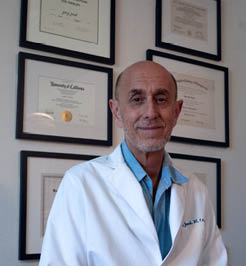

 TAC: What made you become interested in soft tissue methods?
TAC: What made you become interested in soft tissue methods?
 Dr. Horwitz was selected by the United States Olympic Committee as the sole chiropractor on the sports medicine staff of the 1996 Olympic Team and in that same year was appointed by the Governor to the Maryland Advisory Council on Physical Fitness. He served as the Chairman from 2002 to 2004. Dr. Horwitz was elected as the Maryland State Director for the National Strength and Conditioning Association from 2004 – 2010.
Dr. Horwitz was selected by the United States Olympic Committee as the sole chiropractor on the sports medicine staff of the 1996 Olympic Team and in that same year was appointed by the Governor to the Maryland Advisory Council on Physical Fitness. He served as the Chairman from 2002 to 2004. Dr. Horwitz was elected as the Maryland State Director for the National Strength and Conditioning Association from 2004 – 2010.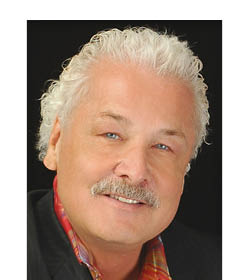
 In a Q & A session with Dr. Ken Murkowski, Dr. Versendaal talks about his past and present. Also revealed are some of the interesting beginnings of Contact Reflex Analysis® (CRA), as well as where Dr. Versendaal sees his influence as it relates to the Science, Philosophy and Art of chiropractic. Join us in reviewing this inspiring history, for Dr. Versendaal’s 76th Birthday celebration.
In a Q & A session with Dr. Ken Murkowski, Dr. Versendaal talks about his past and present. Also revealed are some of the interesting beginnings of Contact Reflex Analysis® (CRA), as well as where Dr. Versendaal sees his influence as it relates to the Science, Philosophy and Art of chiropractic. Join us in reviewing this inspiring history, for Dr. Versendaal’s 76th Birthday celebration. KM: Is CRA easy to learn and reproduce by young practitioners today?
KM: Is CRA easy to learn and reproduce by young practitioners today?
 Dr. Jardine is the co-creator of SpiderTech which has become a globally recognized brand delivering kinesiology taping products and education. On top of providing the professional health care market with an easier, more standardized approach to kinesiology taping, Dr. Jardine has brought the field of chiropractic to a world stage of credibility with the endless traveling and presenting he does for all health care professions.
Dr. Jardine is the co-creator of SpiderTech which has become a globally recognized brand delivering kinesiology taping products and education. On top of providing the professional health care market with an easier, more standardized approach to kinesiology taping, Dr. Jardine has brought the field of chiropractic to a world stage of credibility with the endless traveling and presenting he does for all health care professions. TAC: What type of chiropractic techniques do you prefer?
TAC: What type of chiropractic techniques do you prefer?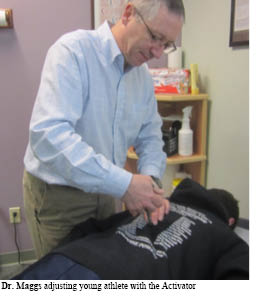
 TAC: Dr. Maggs, let’s start with a little about your background.
TAC: Dr. Maggs, let’s start with a little about your background. TAC: How can examining and treating middle and high school athletes help our healthcare costs?
TAC: How can examining and treating middle and high school athletes help our healthcare costs? The standing x-ray, in my opinion, is the most important test when determining the biomechanics of a human being. To ever suggest that the x-ray only should be considered when you suspect pathology is both ignorant and destructive to the well-being of humanity. Looking at the athlete as an architectural structure, the x-ray provides the details of the corrective treatments needed for maximum improvement. Athletes need visual evidence to become motivated to take the action required, and there is no visual proof greater than the x-ray.
The standing x-ray, in my opinion, is the most important test when determining the biomechanics of a human being. To ever suggest that the x-ray only should be considered when you suspect pathology is both ignorant and destructive to the well-being of humanity. Looking at the athlete as an architectural structure, the x-ray provides the details of the corrective treatments needed for maximum improvement. Athletes need visual evidence to become motivated to take the action required, and there is no visual proof greater than the x-ray.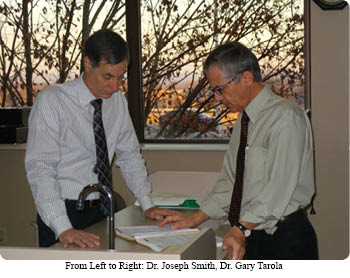
 Dr. Tarola served as president and chairman of the board of the Pennsylvania Chiropractic Society (PCS). He received Chiropractor of the Year award from the PCS and Senatorial Proclamation of Accomplishments from the Pennsylvania State Senate.
Dr. Tarola served as president and chairman of the board of the Pennsylvania Chiropractic Society (PCS). He received Chiropractor of the Year award from the PCS and Senatorial Proclamation of Accomplishments from the Pennsylvania State Senate.  pain management physician and I have been discussing the concept of a multi-specialty spine program. Because of the health network’s prominent role in serving our community, we decided a number of years ago that it would probably be best to initiate this program through the network.
pain management physician and I have been discussing the concept of a multi-specialty spine program. Because of the health network’s prominent role in serving our community, we decided a number of years ago that it would probably be best to initiate this program through the network.
 Tarola: It’s important to be able to communicate with all providers on their level, and with confidence. To make it known that you know what you can do and can’t do, you know what their potential is and what their limitations are, and you communicate that in a professional, matter of fact sort of way. They develop an element of respect, then trust and referrals start coming your way. I would say that’s largely how my reputation developed in my community. And then it spreads; it sort of snowballs. Providers talk to other providers.
Tarola: It’s important to be able to communicate with all providers on their level, and with confidence. To make it known that you know what you can do and can’t do, you know what their potential is and what their limitations are, and you communicate that in a professional, matter of fact sort of way. They develop an element of respect, then trust and referrals start coming your way. I would say that’s largely how my reputation developed in my community. And then it spreads; it sort of snowballs. Providers talk to other providers. would discuss my assessment of the patient’s condition, treatment provided to that point if any and results of same, why I’m referring and for what, i.e.; evaluation only or evaluation and treatment, and what kind of treatment I felt was appropriate. For those who might want to position themselves similarly, I think you have to start out that way. It’s necessary to communicate as much as possible, make sure the communication is proper, appropriate, and that the terminology used is germane to all healthcare providers. Avoid using chiropractic jargon that no one else would understand.
would discuss my assessment of the patient’s condition, treatment provided to that point if any and results of same, why I’m referring and for what, i.e.; evaluation only or evaluation and treatment, and what kind of treatment I felt was appropriate. For those who might want to position themselves similarly, I think you have to start out that way. It’s necessary to communicate as much as possible, make sure the communication is proper, appropriate, and that the terminology used is germane to all healthcare providers. Avoid using chiropractic jargon that no one else would understand.
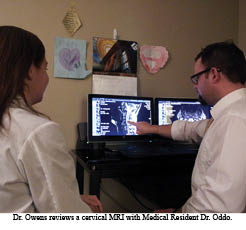
 In an interview with Dr. Cory Littman, Dr. Owens shares some of the ways that he is helping medical doctors collaborate with chiropractic as a first line option for spinal related problems. Dr. Owens is creating the paradigm shift where the Primary Care Medical Physician coming out of Medical Residency has accepted chiropractic doctors as primary care for everything spine.
In an interview with Dr. Cory Littman, Dr. Owens shares some of the ways that he is helping medical doctors collaborate with chiropractic as a first line option for spinal related problems. Dr. Owens is creating the paradigm shift where the Primary Care Medical Physician coming out of Medical Residency has accepted chiropractic doctors as primary care for everything spine. Dr. Cory Littman: You mentioned something in one of our earlier conversations that I feel is important to bring up here. You said, “Nowhere in their training, medical school or residency are primary care medical doctors instructed to refer musculoskeletal conditions to physical therapy only.” Can you expand on that for the readers?
Dr. Cory Littman: You mentioned something in one of our earlier conversations that I feel is important to bring up here. You said, “Nowhere in their training, medical school or residency are primary care medical doctors instructed to refer musculoskeletal conditions to physical therapy only.” Can you expand on that for the readers?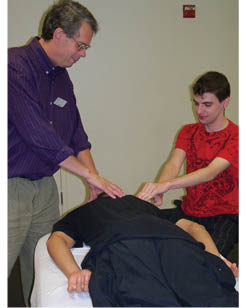
 KOCH: Jeff, I must tell you that I have been studying your DVDs and am very impressed with your work. The ease, with which you present your material and your knowledge of the details of the anatomy of the entire musculoskeletal system, makes it very easy and enjoyable to watch, understand and apply.
KOCH: Jeff, I must tell you that I have been studying your DVDs and am very impressed with your work. The ease, with which you present your material and your knowledge of the details of the anatomy of the entire musculoskeletal system, makes it very easy and enjoyable to watch, understand and apply.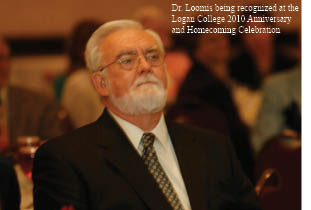
 In 1980, he was introduced to the work of Dr. Edward Howell, M.D. and his Food Enzyme Concept in his books, Enzymes for Health and Longevity and Enzyme Nutrition. It changed the entire focus of Dr. Loomis’ practice.
In 1980, he was introduced to the work of Dr. Edward Howell, M.D. and his Food Enzyme Concept in his books, Enzymes for Health and Longevity and Enzyme Nutrition. It changed the entire focus of Dr. Loomis’ practice.  In 1980, I was fortunate to be introduced to the work of Edward Howell, M.D. and his “Food Enzyme Concept.” After reading his two books, Enzymes for Health and Longevity and Enzyme Nutrition, I was convinced that he had found the missing link for providing consistent results in clinical nutrition.
In 1980, I was fortunate to be introduced to the work of Edward Howell, M.D. and his “Food Enzyme Concept.” After reading his two books, Enzymes for Health and Longevity and Enzyme Nutrition, I was convinced that he had found the missing link for providing consistent results in clinical nutrition. TAC: What type of chiropractor/chiropractic practice fits best with this paradigm?
TAC: What type of chiropractor/chiropractic practice fits best with this paradigm?